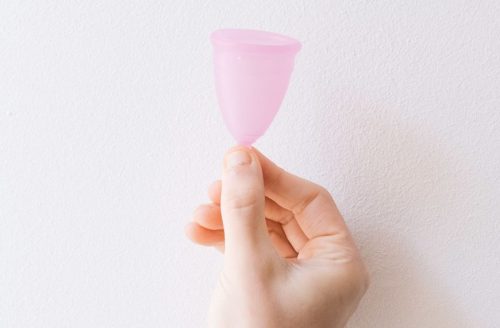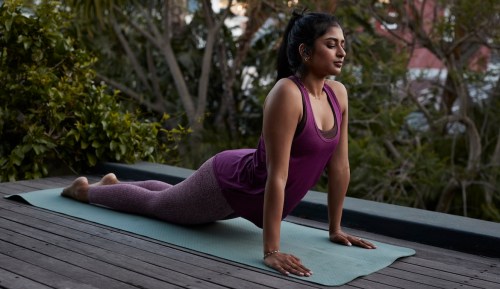Our editors independently select these products. Making a purchase through our links may earn Well+Good a commission
Ready to ditch pads and tampons for good? Here’s how to choose the best menstrual cup for you
Find out how to choose the best menstrual cup for you based on your needs—and *exactly* how to use it.

Given all the buzz surrounding menstrual cups—wellness faves like Lee Tilghman (AKA Lee From America) and Lauren Singer swear by them—you might be surprised to hear that the doohickies are not a new invention. The first usable commercial cup was patented in 1937 by American actress Leona Chalmers (*the more you know*). Today, after several decades and many adjustments made to the original model, there are nearly as many varieties of menstrual cups to choose from as there are tampons and feminine pads.
So, what exactly is a menstrual cup? At it’s most basic, it’s a vessel that’s designed to be inserted into the vagina to collect menstrual fluid, in lieu of a pad, tampon, or period-proof workout shorts (yep, that’s a thing). Cups are typically bell shaped, stemmed for easy removal, and made from medical-grade silicone or rubber.
Now that we’ve got that covered, we can move on to the million-dollar question: How do you use one?
Keep reading to see if a menstrual cup may be right for you—and how to choose the best one for your needs.
The pros
The surge in popularity of menstrual cups is largely attributed to its eco-friendliness and cost effectiveness. One cup can be reused for up to five years or longer—so while the initial cost of the cup may be higher than a box of pads or tampons (but at $15-$40 per cup we’re not talking by much), making the switch will save you a pretty penny in the long run.
Plus: In addition to the decreased waste avoided by not regularly disposing of tampons or pads themselves, the fact that it’s reusable means you don’t have to throw away handfuls of wrappers and applicators each month.
The cons
Real talk: There is a learning curve associated with using menstrual cups. Some users may have difficulty inserting the cup, particularly younger girls or women who have never had intercourse. Women with IUDs should consult with their OB/GYN or primary care physician, as the cup could potentially catch the string of the IUD, potentially dislodging it.
Menstrual cups also present a potential for mess when emptying the cup. (If you’re a cup skeptic, this is likely why.) It’s recommended that you empty the cup while hovering over the toilet and ideally at home, so that you have easy access to a sink for washing your hands and rinsing the cup.
Recent studies have shown that menstrual cups allow more air to enter the vagina compared to tampons. Increased airflow creates a more favorable environment for bacteria to grow, which may increase the risk of Toxic Shock Syndrome (TSS) (a potentially fatal bacterial illness associated with tampon use). That said, TSS is rare (about 1 in 100,000 people annually) and as with tampon use, you can reduce your risk by washing your hands before inserting the cup and be sure to empty the cup at least every eight hours.
How to use a menstrual cup
Okay, let’s get down to it.
- 1.Fold or pinch the cup vertically to reduce its width, allowing for easier insertion into the vagina.
- 2.Once inserted, the cup will unfold and should create a seal against the vaginal walls. The cup shouldn’t leak or cause discomfort. If either of these occur, adjust the cup by twisting it or flexing the vaginal muscles. When properly inserted, you should barely feel the cup if you even notice it at all.
- 3.Depending on your flow, remove the cup after four to eight hours of use by pinching the base of the cup and pulling. Don’t pull it out by the stem because that could create additional suction, making it more difficult to remove.
- 4.Empty the cup into the toilet, rinse it out, and reinsert. If you can’t easily get to a sink to rinse the cup (like in many public restrooms), you can wipe it out with clean tissue or a wet wipe, and then rinse the cup when you are next able to. You can also consider carrying a water bottle with you to rinse the cup in these situations.
- 5.At the end of your menstrual cycle, wash the cup with a mild soap and sterilize it in boiling water for a few minutes before storing.
If you feel you’ve inserted the cup properly but leakage continues to occur, you should consider emptying the cup more frequently or purchasing a larger sized cup.
How to choose the best menstrual cup for you
Most brands sell cups in small and large sizes. The small size is typically recommended for women under the age of 30 who have not given birth vaginally, for light flows, and/or first-time cup users. Larger sizes are intended for women more than 30 years of age, who have given birth vaginally, or have a heavy flow. (Side note: Is it possible to hear the words “heavy flow” without having Mean Girls flashbacks?)
Because not all vaginas and not all menstrual cups are made the same, you may have to do some Goldilocks-style trial and error before you find the right menstrual cup. And don’t be discouraged if your first choice isn’t a perfect fit; it’s hard to purchase “the one” on the first try.
To help narrow down the field, we’ve scoured numerous articles and user reviews to find the four most popular cups on the market.
MeLuna Classic; $25
Manufactured in Germany and popular throughout Europe, MeLuna comes in a variety of sizes, making it a good brand to explore for first-time cup users. The MeLuna website even offers a size calculator to help you find the right cup.
To buy: MeLuna
The DivaCup; $30
DivaCup has been around for 15 years, making it one of the best-known cups on the market and the first cup many women try. Available in two sizes, DivaCup features extra-grip ridges for easy removal and was the first cup to receive MDSAP (Medical Device Single Audit Program) certification.
To buy: Amazon
Lena; $40
Lena offers cups in small and large sizes as well a sensitive model, made from a slightly softer silicone that is more ideal for first-time cup users or those with a sensitive anatomy or bladder. If you’re not sure which cup size to buy, Lena also sells a two-pack containing a small and large cup that can be alternated based on your flow.
To buy: Amazon
Blossom; $14 and up
Blossom cups are one of the most affordable cups on the market and have a money-back guarantee, making it a good introductory cup. Reviewers also rave about the softness of the Blossom cup.
To buy: Amazon
Finding the right fit
If you’re a fan of tampons, then the internal solution of a menstrual cup might be a good fit for you. The biggest takeaway is this: if you want to save money and find a more environmentally-friendly solution for your periods, then try the menstrual cup—and then try it again—because experimentation is the name of the game. Don’t necessarily expect to get it right on your first try, and don’t give up if all doesn’t go as planned from the beginning. You’ll be a menstrual cup pro before you know it.
Need more intel? An expert gives a detailed (no such thing as TMI here, folks!) explanation of how to use one. And thanks to this new product, period sexy just got a lot less messy.
Sign Up for Our Daily Newsletter
Get all the latest in wellness, trends, food, fitness, beauty, and more delivered right to your inbox.
Got it, you've been added to our email list.










